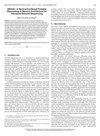A DSP-Based Precision-Scalable MAC With Hybrid Dataflow for Arbitrary-Basis-Quantization CNN Accelerator
IF 1.4
3区 计算机科学
Q4 COMPUTER SCIENCE, HARDWARE & ARCHITECTURE
引用次数: 0
Abstract
Precision-scalable convolutional neural networks (CNNs) offer a promising solution to balance network accuracy and hardware efficiency, facilitating high-performance execution on embedded devices. However, the requirement for small fine-grained multiplication calculations in precision-scalable (PS) networks has resulted in limited exploration on FPGA platforms. It is found that the deployment of PS accelerators encounters the following challenges: LUT-based multiply-accumulates (MACs) fail to make full use of DSP, and DSP-based MACs support limited precision combinations and cannot efficiently utilize DSP. Therefore, this brief proposes a DSP-based precision-scalable MAC with hybrid dataflow that supports most precision combinations and ensures high-efficiency utilization of DSP and LUT resources. Evaluating on mixed 4 b/8b VGG16, compared with 8b baseline, the proposed accelerator achieves 3.97× improvement in performance with only a 0.37% accuracy degradation. Additionally, compared with state-of-the-art accelerators, the proposed accelerator achieves 1.20 × −2.69× improvement in DSP efficiency and 1.63 × −6.34× improvement in LUT efficiency.基于dsp的高精度可扩展MAC混合数据流用于任意基量化CNN加速器
精确扩展卷积神经网络(cnn)为平衡网络精度和硬件效率提供了一个有前途的解决方案,促进了嵌入式设备的高性能执行。然而,在精确可扩展(PS)网络中对小粒度乘法计算的需求导致了对FPGA平台的有限探索。研究发现,PS加速器的部署面临以下挑战:基于lut的乘法累加(mac)不能充分利用DSP,基于DSP的mac支持有限的精度组合,不能有效地利用DSP。因此,本文提出了一种基于DSP的高精度可扩展MAC,它具有混合数据流,支持大多数精度组合,并确保DSP和LUT资源的高效利用。在4b /8b混合VGG16上进行评估,与8b基线相比,该加速器的性能提高了3.97倍,精度仅下降了0.37%。此外,与最先进的加速器相比,该加速器的DSP效率提高了1.20 ×−2.69倍,LUT效率提高了1.63 ×−6.34倍。
本文章由计算机程序翻译,如有差异,请以英文原文为准。
求助全文
约1分钟内获得全文
求助全文
来源期刊

IEEE Computer Architecture Letters
COMPUTER SCIENCE, HARDWARE & ARCHITECTURE-
CiteScore
4.60
自引率
4.30%
发文量
29
期刊介绍:
IEEE Computer Architecture Letters is a rigorously peer-reviewed forum for publishing early, high-impact results in the areas of uni- and multiprocessor computer systems, computer architecture, microarchitecture, workload characterization, performance evaluation and simulation techniques, and power-aware computing. Submissions are welcomed on any topic in computer architecture, especially but not limited to: microprocessor and multiprocessor systems, microarchitecture and ILP processors, workload characterization, performance evaluation and simulation techniques, compiler-hardware and operating system-hardware interactions, interconnect architectures, memory and cache systems, power and thermal issues at the architecture level, I/O architectures and techniques, independent validation of previously published results, analysis of unsuccessful techniques, domain-specific processor architectures (e.g., embedded, graphics, network, etc.), real-time and high-availability architectures, reconfigurable systems.
 求助内容:
求助内容: 应助结果提醒方式:
应助结果提醒方式:


